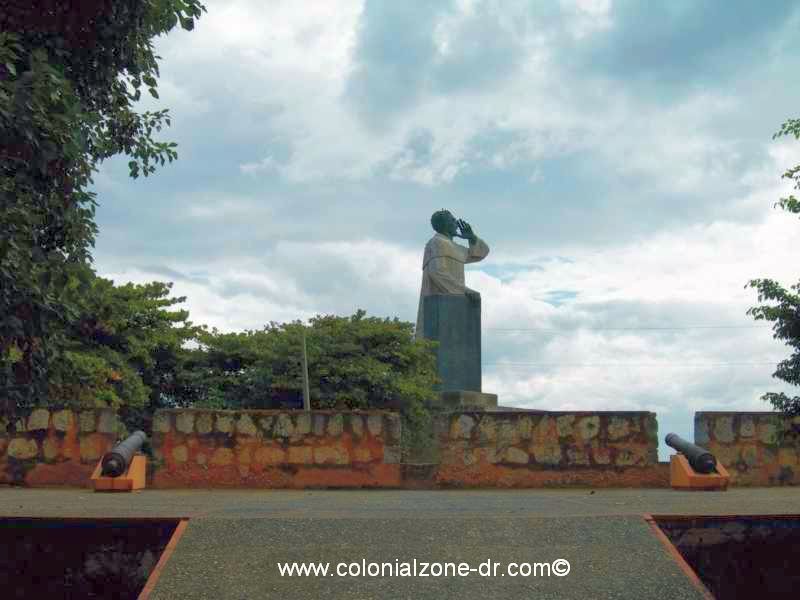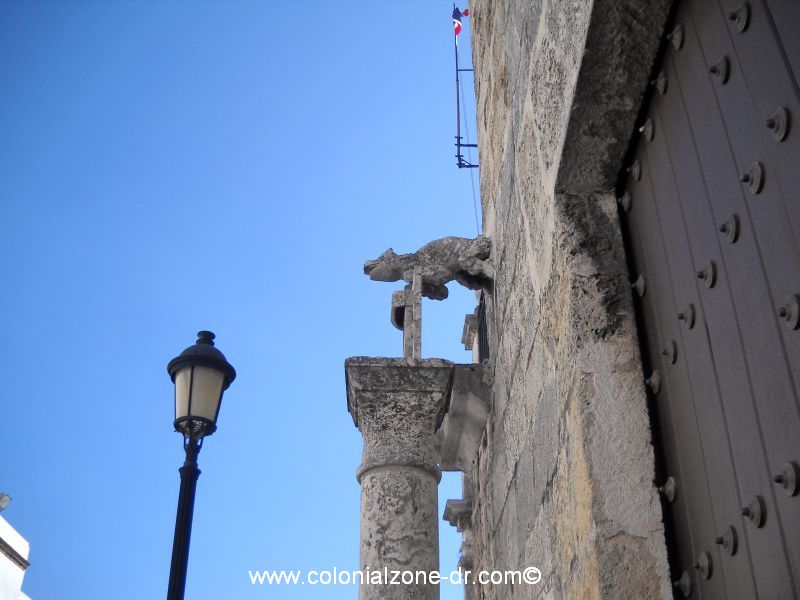Monument to Fray Anton de Montesinos | Casa del Tostado/ House of Tostado | Casa de Bastidas/ House of Bastidas | Casa de Hernán Cortés | Casa de los Jesuitas/ House of the Jesuites | Casa de las Gárgolas/ House of the Gargoyles | Casa del Tapao | Colegio de Gorjón (Centro Cultural de Espańa) / College or School of Gorjón (Cultural Center of Spain) |
Montesinos was one of the first to inhabit the Convento e Iglesia de los Dominicos/ Monastery and Church of the Dominican Order. He is known for his historic defense of the Taino Indians. He courageously spoke against the abuses done to the native peoples of the island in a famous sermon made in 1511.
The statue measuring 150 feet (30 meters) tall is seen at the entrance to the port at Rio Ozama and the Santo Domingo Harbor along the Malecon. This gigantic statue was a gift from the Mexican Government to the Dominican Republic when Lopez Portillo was president of Mexico. There is a small plaza in front of the statue and is a nice place to start your walk down the Malecon along the sea.
Casa de Bastidas/ House of Bastidas
Captain Rodrigo de Bastidas, the Almojarife Mayor (Principal Royal Tax Collector) and governor of Santo Domingo, built this to be his residence. It is not constructed in the normal style of the time. It more resembled a warehouse, not an estate where people were to live. It was built this way to have two functions, a residence and as a storehouse and safe to keep the Crown revenues and treasure until they could be sent to Spain.There is a plaque in the wall and a stone statue of Santa Bárbara above the door dating from the 18th century.
This building now houses some art galleries. The house has a very large patio adorned with Roman arches where are held concerts and celebrations. It is home to the Trampolín Children's Museum
Hours: Daily 8:00 a.m. to 6:00 p.m.
Directions: Calle las Damas north of Fortaleza Ozama see the map (number 76)
Casa del Tostado / House of Tostado
Directions: Avenida George Washington (The Malecon) in front of Parque San Jose. see the map (number 66)
More about Montesinos on the People In History - Fray Anton de Montesinos page.
Casa de Hernán Cortés or Casa de Francia
This gothic style building was originally constructed by Frey Nicolás de Ovando in 1503 to rent to visitors. The name came about because it was the home of the explorer and conqueror of Mexico, Hernán Cortés. Francisco Pizarro, the conqueror of Peru, Diego Velasquez and Alonso de Ojeda also lived in this house.
Restored in 1978 it become the home of the offices of the French Embassy and Consulate in 1999. The building is now named Casa de Francia. It houses a ballroom, library, small theater, and a gift shop.
Directions: Calle Las Damas and Calle El Conde see the map (number 85)
Casa de los Jesuitas/ House of the Jesuites This stone and brick house is one of the oldest buildings in the city. Governor Ovando in 1701, ordered the Jesuites to build this house to be used as a university. It was completed in 1747 but some twenty years later the Jesuites were banned from the Dominican Republic so the building was given to la Corona. It became the home of the Colegio Santiago de la Paz y Gorjón 1767.
*In November 2006 President Leonel Fernandez announced a new museum to be opened in this building, The Museum for Dominican Music. They will catalogue, research, and save the Dominican music for all to enjoy. The Jesuit House will be remodeled to be the new sight of the museum.
Directions: Calle Las Mercedes in the Colonial Zone see the map (number 41)
Casa de las Gárgolas/ House of the Gargoyles
The House of Gargoyles dates back to the 16th century. It has six Gargoyles that decorate the front of the building. These are water drainage devices that were modeled to represent gargoyles heads. It is thought that they came from the original Cathedral. There are three small balconies on the second floor of the building and only two small windows on the first floor.
his was home to Don José Fernández and later became home to a group called Compańía de Jesús. Through this houses existence it has housed various councils, the Haitian Occupation and more. It was also the home where poet Emilio Prud'Homme and musician José Reyes collaborated to commemorate the Restauración in 1897. Here they wrote the song that became the Dominican National Anthem (1934 it was dedicated as the national anthem). It is now the home of la Fundación Dominicana de Desarrollo/ the Dominican Foundation of Development.
Casa del Tapao / Top of the House /House of the Man's Coat This large stone home was built in the 14th century between 1554 and 1556. It was built with the aide of the Cathedral for dean Duque de Rivera whose shield is atop the stone portal of the main entrance.
This house has a few different legends that are said to have existed behind its walls. It is said that the condemned prisoners arriving here from Mexico stayed in this house and always left covering their faces so no one could identify them.
Another story of the house is that the gentleman living here was deformed from some disease, maybe a leper, and this is the reason he always left the house covered. And yet another story says that this man was the twin brother of the King of Spain who lived here in disgrace. He was a strange person who always kept his face covered so he could not be recognized. The people did not know much about this mysterious man so they called him "el hombre del tapado"
Colegio de Gorjón/ College or School of Gorjón was a vision of rich landowner and sugar tycoon Hernando de Gorjón. Gorjón came to the island in 1502 in the same expedition that brought Fray Governor Nicholas de Ovando and the Licenciado/ Lawyer Bartolomé de las Casas. Since he did not have any heirs he decided to build a college for the study of sciences. Sadly he never got to see its finish since it was not completed until 1550, after his death.

In 1583 it was named part of the University of Santiago of La Paz and was finally confirmed by Cédula Real in 1741 when Fernando VI gave it recognition as the Universidad de Santo Domingo.
The building was restored beautifully in the '70's by the Comisión de Monumentos/ Monument Commission de Santo Domingo. At this time it was decided to make it again a center for learning and culture. In 1990 it was the Centro Cultural Hispánico. Now, since 1998, The Colegio de Gorjón is the home of the Centro Cultural de Espańa/ Cultural Center of Spain (CCEDS http://www.ccesd.org), an institution integrated to the world-wide network of cultural centers of the Spanish Agency of Cooperation the International, AECI.
+click image to enlarge
Front of the Centro Cultural de Espana
Many architectural interests of great historic value can be seen throughout the building starting with the main entrance and windows. The outside can be very deceiving, as the interior is quite large. Entering the building there is a stone vestibule that represents the Elizabethan period in the New World. It is decorated with several shields of arms that were destroyed during the Haitian invasion. The main room was originally a chapel, which today is the exhibition hall named in honor of painter and sculptor Antonio Prats Ventós. The Spanish patio, surrounded by splendid columns, is now the place where are held many outdoor concerts and exhibitions holding about 200 people. Many of the old classrooms are now exhibition halls including Sala Maria Ugarte and the Sala Fotográfica. On the second floor is a library, smaller rooms and offices.
Location: Calle Arz. Merińo and Arz. Portes see the map (number 79)
|
|

site map Copyright © 2005 - 2016 All Rights Reserved. Colonial Zone-Dominican Republic (DR)
Home | Calendar | Night Life/Dining | Sight Seeing | Pictures | Businesses | Artists | Food | Helps | History | Language | Music | Media | Pastimes | Products | Tradition/Legend | Links | About Us | Buy Mamajuana | News Blog | DR Gringa's Life Blog | Dominican Dog Blog

Custom Search

Home | Dining & Night Life | Hotel | Sights | Pictures | Music | Colonial Zone Map | Hot Spots! Directory | Site Search




MENU
IN COLONIAL ZONE
THINGS DOMINICAN
If you found my web site useful please consider making a donation through Pay Pal . Thanks!

Our complete exchange rate tool.
Gracias a coinmill.com
Monument to Fray Anton de Montesinos
+click to enlarge
Statue of Montecinos
+click to enlarge
Top of the Casa de los Jesuitas
Casa de Francisco Tostado is one of the earliest constructions on the island in the 15th century. Tostado came to the island with Nicholas de Ovando in 1502 making him one of the earliest settlers on the island. He was a writer and father of famous writer Francisco Tostado de la Peńa, the first person born on the island to become a university professor, who was killed by cannon fire of Pirate Francis Drake in 1586.
The construction of this house is said to be one of a kind. Inside the rooms are large and spacious and quite lavish. The archways throughout the house are exquisite. The top floor has a great view of the sea. The patio is lovely and it is said at one time there was an orchard here. This house has held many famous inhabitants of the island, first the Tostado family and including Francisco Rodríguez Franco and the house of the Archbishop.
+click to enlarge
Casa de Tostado
When the country took the house over in 1970 it was made into a historical monument. It is now the home of the Museum of the Dominican Family. This museum holds many historical documents of the Dominican national heritage. It shows the culture and customs of the Dominican people. More information about the Museum of the Dominican Family.
This house has one of the most unique windows in all the world. It is an Elizabethan Gothic Window with Moorish influences
Directions: on the corner of Padre Billini and Arzobispo Merińo see the map (number 59)
+click to enlarge
Top of the Casa del Tapao
+click to enlarge
Casa de las Gárgolas
Directions: Calle Las Mercedes between Calle las Damas and Isabel la Catolica near the National Pantheon see the map (number 42)
All these legends have one thing in common; someone stayed here who was secretive and stayed covered. None know for sure now why the inhabitants of this house always seemed to remain under cover. This is another mystery of history that will never be answered here in the Colonial Zone.
Directions: Calle 19 de Marzo and Padre Billini see the map (number 63)




